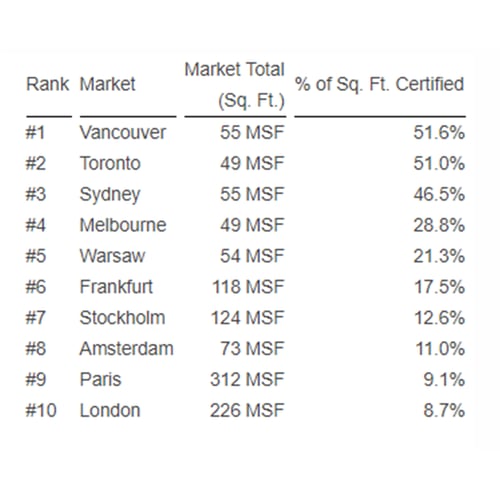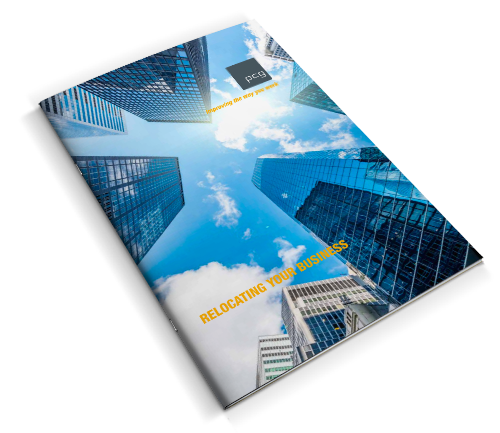With more focus on energy efficiency and reducing office expenditure, it’s beneficial to have a good understanding of the various energy efficient ratings within Australia and the benefits to your organisation before making any decisions on your next corporate real estate space.

‘According to the International Green Building Adoption Index, 18.6 percent of space in 10 markets across Australia, Canada and Europe have been certified “green” since 2007 – when the number was just 6.4 percent.’1
The top 10 rankings are as follows:2
There are a few energy efficient rating systems within Australia with NABERS and Green Star being the most well-known, although the WELL Building Standard – the world’s first building certification that focuses exclusively on human health and wellness is becoming more prominent. WELL, certification has been awarded to several companies within Australia including Mirvac’s George St headquarters and Lendlease’s International Towers at Barangaroo.3
The benefits
As corporate organisations compete to attract and retain the best staff while improving productivity, there will be a greater focus on employee health and well-being. So, it’s understandable there is now a greater focus on how the physical environment of a corporate workplace can contribute to these factors while also reducing operational costs and carbon emissions.
’91 percent of US workers at companies that support well-being efforts say they feel motivated to do their best.’4

Understanding the performance of your building or tenancy in the following areas can help you formulate plans and take steps to save costs and the reduce your impact on the environment.
- Lighting
- Indoor air quality (indoor air quality can be 2-5 times more polluted than outdoor air)5
- Heating and air conditioning
- Water use
- Waste generation
Below is an overview of each rating system and how your organisation can benefit from having an energy efficient certification.
All three rating systems involve registering your building or tenancy, a detailed documentation process followed by an assessment by an accredited assessor. Costs vary based on building or tenancy size and the type of certification you’re seeking.

WELL Building Standard
The WELL Building Standard certification measures the impact of an office environment on the health and productivity of people within it.6 And although WELL is US based it has been certified by the Green Building Council of Australia.’7
WELL offers a framework to help improve health and well-being for everyone that visits, works in, or experiences a building.
WELL Standard certification categories include:
- Air
- Water
- Nourishment (the availability of fresh, wholesome foods, and encourages better eating habits)
- Light
- Fitness (promotes the integration of physical activity into everyday life)
- Comfort (requirements are designed to create distraction-free, productive and comfortable indoor environments)
- Mind (optimises cognitive and emotional health through design, technology and treatment strategies)
- Innovation8
WELL certification applies to the following workplace project types:
- Buildings
- Interiors
- Core
‘US Employers have said their wellness programs have increased productivity by 66% and decreased absenteeism by 50% with employee satisfaction
increasing 67%.’9
According to the WELL website in Australia, there are currently 56 projects including:
- 4 Platinum Certified
- 3 Gold Certified
- 2 Silver Certified

Green Building Council of Australia – Green Star
‘Launched by the Green Building Council of Australia in 2003, Green Star is Australia's only national and voluntary rating system for buildings and communities.’10
The Green Star categories associated with buildings and offices/workplaces assess the sustainable design, construction and operation of buildings and fit-outs.
- Green Star Design & As Built
- Green Star Interiors
- Green Star Performance
Each category above is based on the following nine criteria:
- Management (the adoption of practices that support sustainability outcomes)
- Indoor Environment Quality (IEQ)
- Energy
- Transport
- Water
- Materials
- Land use and ecology
- Emissions
- Innovation (recognise the implementation of innovative practices, processes and strategies)
The Green Star Rating system
- 6 Stars: international excellence
- 5 stars: Australian excellence
- 4 stars: best practice11
‘Green Star buildings are said to produce 62% fewer greenhouse gas emissions than average Australian buildings and use 66% less electricity.’12
NABERS
Another rating system is NABERS, ‘which measures the energy efficiency, water usage, waste management and indoor environment quality of a building or tenancy and its impact on the environment.’13
NABERS is managed nationally by the NSW Office of Environment and Heritage, on behalf of Commonwealth, state and territory governments.
‘Office buildings using NABERS to measure their performance regularly have reported an average improvement in energy efficiency of 8.5% and are now saving 383,300 tonnes of greenhouse gas emissions, every year.’
NABERS ratings for office buildings and tenancies include:
- NABERS Energy
- NABERS Water (base or whole buildings only)
- NABERS Waste
- NABERS Indoor Environment (IE)
NABERS can rate an office tenancy, the base building (central services and common areas) or the whole building (a combination of the base building and tenancies).
The NABERS Energy, Water and Indoor Environment tools for offices measure performance on a rating scale from 0 to 6 stars.
- 6 stars: Market leading performance
- 5 stars: Excellent performance
- 4 stars: Good performance
- 3 stars: Average performance
- 2 stars: Below average performance
- 1 star: Poor performance
- 0 stars: Very poor performance15
The NABERS IE data can also be used to contribute to a Green Star Performance rating.
The kinds of information required to be credited include energy consumption data, net lettable area, number of computers in use and hours of occupancy and for IE an occupant satisfaction survey and quantitative measurements.
The benefits of occupying a green certified building indeed suggest there are significant savings to be made both regarding occupational costs and through staff engagement, productivity and wellness.
If you would like any assistance with your lease negotiations and ensuring your commercial lease is within a green certified building, please don’t hesitate to contact us.
You May Also Like:
- Don’t Forget These 5 Property & Workplace Considerations
- Stay or Go?
- 8 Tips to Reduce Office Energy Costs
Acknowledgements
1. The Urban Developer, ‘Australian Offices Among The Greenest.’ Viewed May 2018.
2. Architecture and Design, 'Australia leading the world in green building adoption.' Viewed May 2018.
3. Australian Financial Review, 'All is well for Lendlease at Barangaroo.' Viewed May 2018.
4. American Psychological Association,2016, 'Workplace well-being.' Viewed May 2018.
5. Paint Inspection, 'Sick building syndrome infographic.' Viewed May 2018.
6. Australian Financial Review, 'Well, well well: green building council partners with US certification institute.' Viewed May 2018.
7. Australian Financial Review, 'Workplace wellness gaining traction across Asia Pacific.' Viewed May 2018.
8. WELL Building Standard. Viewed May 2018.
9. Rise People, '25 Fascinating statistics about workplace wellness.' Viewed May 2018.
10. Green Building Standard Australia, 'Green Star.' Viewed May 2018.
11. Green Building Standard Australia, 'Green Star.' Viewed May 2018.
12. Green Building Standard Australia, 'Green Star.' Viewed May 2018.
13. NABERS. Viewed May 2018.
14. NABERS, 'Research Statistics.' Viewed May 2018.
15. NABERS, 'Six Star Rating.' Viewed May 2018.











Share your thoughts